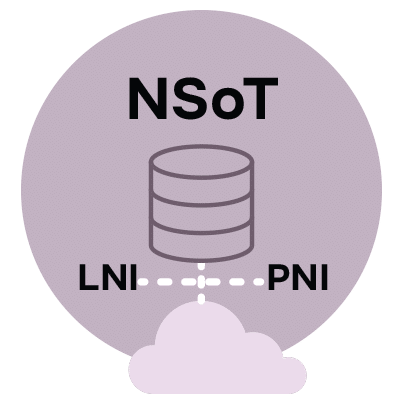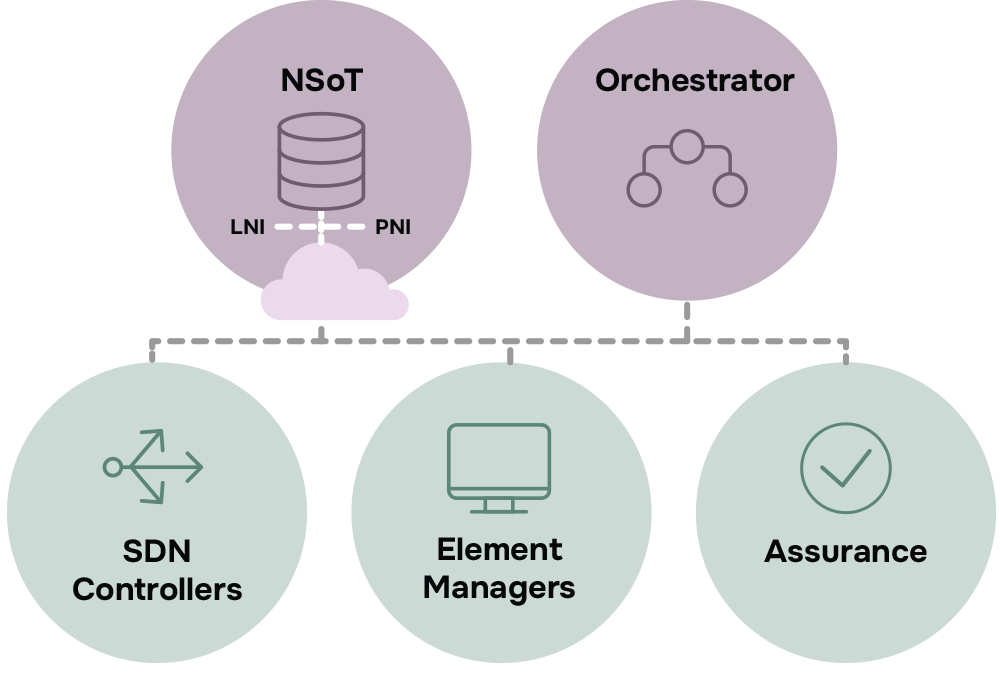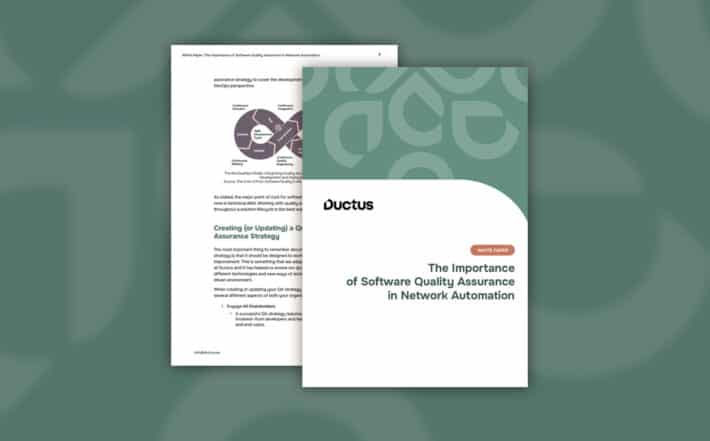
INSIGHT
Why Every Automated Network Needs a Source of Truth
In modern network automation, reliable data is everything. As networks grow more complex, a Network Source of Truth (NSoT) becomes essential. It acts as a central, authoritative source of network data—driving consistency, efficiency, and scalability across automation workflows. This insight explores the concept of an NSoT, its critical role in enabling effective automation, and why organizations must prioritize its implementation to support operational agility and security.
What Is a Network Source of Truth?
An NSoT is more than just a data repository—it is the authoritative reference for your entire network environment. It consolidates all critical network information in one place, providing a consistent and unified view that can be trusted by both humans and automation systems.
Specifically, an NSoT maintains accurate data across
- Physical Network Inventory (PNI)
- Logical Network Inventory (LNI)

This centralized foundation allows every automation tool and operational process to work from the same up-to-date source, significantly improving efficiency, consistency, and reliability.
Why Network Source of Truth Matters in Automation
To understand the practical value of an NSoT, consider how it underpins nearly every facet of network automation. From provisioning and scaling to troubleshooting and change management, an NSoT enables teams to execute with clarity and confidence.
These are some of the most impactful ways it supports automation:
Data Consistency Across Systems – Automation tools often rely on fragmented data. An NSoT eliminates mismatches by acting as a single point of reference.
Streamlined Workflows – Provisioning, configuration changes, and incident resolution all benefit from up-to-date, trusted data.
Better Troubleshooting & Change Management
A unified network view helps engineers spot and resolve discrepancies faster.
Scalable Operations
As the network grows, NSoT scales with it—supporting increasingly complex automation scenarios.
Federated Inventory: Central Oversight with Local Control
Most large-scale networks are managed by multiple domain-specific tools and teams. In this reality, having a single system directly manage every domain isn’t always practical.
That’s where NSoT’s federation capabilities come into play. Instead of replacing your existing domain managers, NSoT synchronizes with them—maintaining an up-to-date, unified inventory across the entire network.
This approach provides important benefits:
- Keeps NSoT continuously updated through synchronization with domain managers
- Allows domain-specific tools to handle detailed operational management
This hybrid approach maintains a central view while preserving flexibility. The NSoT becomes the backbone of your network inventory—without disrupting what already works.
Key Benefits of a Network Source of Truth
An NSoT delivers tangible advantages across operational, security, and compliance domains. Here’s a balanced breakdown of the core benefits:
Enhanced Accuracy – Reduces configuration errors and minimizes downtime by ensuring automation runs on validated, up-to-date data.
Faster Deployments – Speeds up provisioning of new devices and services using reliable data exposed through automation-friendly APIs.
Improved Security – Enables consistent enforcement of security policies by offering a unified, current view of the network.
Regulatory Compliance – Simplifies audits and ensures traceability by maintaining a centralized record of configurations and changes.
Greater Business Adaptability – Empowers teams to implement changes faster and more confidently, helping the organization respond to shifting demands.
Each of these benefits contributes to a network environment that is more resilient, efficient, and strategically aligned.
Building & Maintaining a Network Source of Truth
Before building your NSoT, take time to define your network automation architecture. Refer to existing reference architectures or consult with a systems integration partner to ensure alignment with your long-term strategy.
Here are four key considerations to guide your implementation:
1. Choose the Right Tools
Select a platform that aligns with your architecture. Common choices include NetBox, Nautobot, and custom-built solutions. Your NSoT should integrate easily with the rest of your automation ecosystem.
2. Define Standards and Regulatory & Security Policies
Establish naming conventions, metadata structures, and validation rules early. These are essential if you’re pursuing a data-driven approach, where consistent identifiers are critical for joining and correlating collected data across systems.
3. Automate Inventory Data Synchronization
Integrate the NSoT with subordinate domain inventories and implement synchronization logic based on your defined policies to keep your inventory fresh and accurate. The goal is to maintain a continuously up-to-date view of the network with minimal manual input.
4. Integrate with Your Automation Frameworks
Your NSoT should be tightly connected with automation tools such as:
- Cisco Crosswork NSO
- Ansible
- Terraform
- Camunda
- Python scripts
- Network assurance and domain-specific tools
Integrations can be bidirectional. This allows the NSoT to both:
- Drive automation workflows
- Be updated based on real-time network state
This two-way sync maintains alignment between operational reality and documented intent.

Discrepancies between the actual state of the network and the documented state in the NSoT are inevitable. When they occur, it’s essential to have a clear policy in place. Should the NSoT be updated to match the live network? Or should the network be adjusted to align with the NSoT?
This is more than a technical decision—it’s about maintaining governance and trust across automated workflows.
Recommended approach: When the network and the NSoT diverge, treat the NSoT as the source of truth. However, ensure fallback procedures are in place to handle out-of-band changes if the automation becomes unavailable.
This keeps automation consistent and reduces the risk of errors. Aligning the network to the NSoT—rather than the other way around—supports proactive governance and protects operational integrity.
Common Challenges & How to Overcome Them
Implementing an NSoT isn’t without its hurdles. But knowing what to expect—and how to respond—can save significant time and reduce friction along the way.
Initial Data Accuracy – The quality of your NSoT depends on the accuracy of your initial dataset. Run comprehensive audits before importing anything. Data integrity at this stage determines how trustworthy and effective your automation will be.
Keeping Data Updated – Outdated data erodes confidence and undermines workflows. Build automated syncs wherever possible, and set up clear processes for manual updates when automation isn’t feasible.
Ongoing Maintenance – Treat your NSoT as a living system. Networks change constantly—ensure your source of truth evolves with them. Establish ownership and review cycles to keep data continuously aligned.
Cultural and Organizational Resistance – Shifting to a centralized system requires buy-in from all stakeholders. Focus on internal education, early success stories, and visible benefits. Buy-in is earned by showing how an NSoT makes teams more efficient—not by mandate.
A Strategic Business Case
An NSoT isn’t just a ‘nice to have’ —it’s a strategic enabler with measurable business value. Here’s how it supports both network teams and enterprise objectives:
Cost Savings – Manual troubleshooting and configuration errors cost time and money. According to a study from Enterprise Management Associates (EMA), network engineers spend on average 39% of their time resolving issues—much of which can be avoided with trusted, automated processes powered by an NSoT.
Faster Time to Market – An NSoT standardizes provisioning, allowing new services, devices and integrations to be deployed rapidly through repeatable, reliable workflows. This agility allows businesses to capitalize on new revenue streams and maintain a competitive edge in dynamic markets.
Improved Network Security – By acting as a central policy enforcer, an NSoT reduces misconfigurations and risk exposure. IBM reported 2023 that the average cost of a breach is $4.45 million—making security consistency a business imperative.
Workforce Productivity – With a reliable data layer in place, automation can handle repetitive tasks—freeing engineers to focus on architecture, optimization, and innovation.
Improved Customer Experience
Stable, well-governed networks deliver more reliable service and faster time-to-resolution. That positively impacts retention rates and customer lifetime value.
Regulatory Compliance
Meeting compliance requirements often involves time-consuming audits and manual data reconciliation. An NSoT simplifies this by maintaining a centralized, auditable record of network configurations and changes. The result? Less overhead, easier audits, and reduced risk of service degradation or regulatory penalties.
Looking Ahead: The Role of a Network Source of Truth in Future Automation
As networks scale and automation matures, consistent, authoritative data becomes the backbone of every decision. A Network Source of Truth (NSoT) provides this foundation by ensuring that every automated process—from provisioning to remediation—operates on trusted, policy-aligned data.
Looking ahead, closed-loop automation, AI-assisted operations, and intent-based networking can greatly benefit from an accurate view of the network’s state and intended outcomes. Realizing these capabilities at scale depends heavily on a well-maintained NSoT.
Designing the next generation of infrastructure requires more than just individual tools. An NSoT becomes the architectural anchor of a future-proof solution for adaptive, resilient, and intelligent network operations.
The Bottom Line
An NSoT isn’t just a technical upgrade. It’s a strategic investment that helps organizations reduce costs, streamline operations, and build automation that scales with confidence.
Beyond efficiency gains, aligning technical workflows with business intent transforms the NSoT into a foundation for delivering stable, secure, and customer-focused services.
In a world of increasing complexity, it’s the anchor that keeps innovation moving in the right direction.
Ready to Build a Reliable Network Source of Truth?
Whether you’re just starting your automation journey or refining an existing architecture, we can help you design and implement a source of truth tailored to your network.

Peter Sallenhag
peter.sallenhag(at)ductus.se
Phone: +46 70 571 05 82









